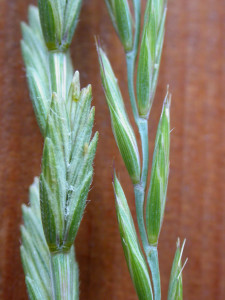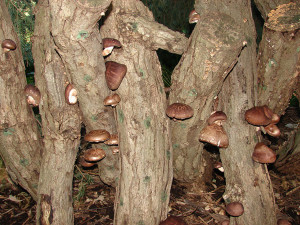2016 Community Science Program proposals build upon DOE JGI-generated reference genomes.

Jesse Poland of Kansas State University proposed sequencing intermediate wheatgrass (Thinopyrum intermedium, alternately known as Agropyron intermedium), shown on the left. Intermiedate wheatgrass has a biomass yield equivalent to that of the candidate bioenergy feedstock switchgrass. The right-hand specimen is of Agropyron repens, which co-occurs with Agropyron intermedium. (Matt Lavin, CC BY-SA 2.0 Wikimedia Commons)
The U.S. Department of Energy Joint Genome Institute (DOE JGI), a DOE Office of Science User Facility, has announced that 27 new projects have been selected for the 2016 Community Science Program (CSP).
“These new CSP projects, selected through our external review process, exploit DOE JGI’s cutting-edge capabilities in nucleic acid sequencing and analysis and build our portfolio in key focus areas including sustainable bioenergy production, plant microbiomes and terrestrial biogeochemistry,” said Susannah Tringe, DOE JGI User Programs Deputy.
The CSP 2016 projects were selected from 74 full proposals received, resulting from 98 letters of intent submitted. The total allocation for the CSP 2016 portfolio is estimated to tap nearly 40 trillion bases (terabases or Tb) of the DOE JGI’s plant, fungal and microbial genome sequencing capacity. The full list of projects may be found at http://jgi.doe.gov/our-projects/csp-plans/fy-2016-csp-plans/.
One reference genome, many applications
Several projects highlight how a single reference genome can be applied to advance previously supported studies, while others focus on plant-microbial interactions. Two, in particular, leverage recent DOE Office of Biological and Environmental Research (BER) Sustainable Bioenergy awards.
Daniel Schachtman from the University of Nebraska, Lincoln proposed a project focusing on a systems analysis of Sorghum bicolor, a potential bioenergy feedstock sequenced by the DOE JGI and published in the journal Nature in 2009. The project seeks to understand how genotype—its underlying genetic makeup—microbiome composition, and the environment influence sorghum’s phenotype—the plant’s observable traits. This work is also supported by a Sustainable Bioenergy grant to Schachtman as well as colleagues at the Donald Danforth Plant Science Center and the University of North Carolina.
Another project aimed at improving bioenergy crop yields comes from Tom Juenger at University of Texas at Austin. By sequencing several hundred switchgrass genotypes, the team hopes to identify genetic variations that contribute to high yields and high quality plant biomass that can be used for biofuel production. Juenger’s project dovetails with his Sustainable Bioenergy Crop Development grant through BER. For this funding opportunity, BER solicited applications for systems-biology driven basic research focused on understanding the roles of microbes and microbial communities in contributing to the health of bioenergy crop feedstocks and their associated ecosystems.
There are four projects utilizing the Chlamydomonas reinhardtii genome resource generated by the DOE JGI in 2007, for example. One project from University of California, Berkeley’s Kris Niyogi involves resequencing algal mutants to identify genes related to photosynthesis. Another comes from Sabeeha Merchant at the University of California, Los Angeles investigating algae that colonize snow in the Arctic as potential feedstocks in algal farms for biofuel.

The CSP project led by Clark University’s David Hibbett focuses on an in-depth genomic survey of the Lentinula genus. Lentinula is a group of white-rot, wood-decaying fungi perhaps best known as the genus of shiitake mushrooms, Lentinula edodes. (Image by dominik18s via Flickr CC BY 2.0)
From Jesse Poland of Kansas State University is a proposal to sequence intermediate wheatgrass (Thinopyrum intermedium), a perennial distantly related to wheat and with a biomass yield equivalent to switchgrass. By producing a whole-genome assembly of intermediate wheatgrass, and then conducting comparative analyses with the DOE JGI Flagship and grass model species Brachypodium distachyon, and with wheat, the team hopes to develop genomic resources that can be applied toward methods for improving the productivity of candidate bioenergy feedstock grasses.
Inter-organismal interactions
In addition to the Juenger project noted above, a project from J. Chris Pires at the University of Missouri focuses on the symbiotic relationship between orchids and fungi. Orchids are found around the world and their seeds rely on carbon solely provided by mycorrhizal fungi to germinate and develop into seedlings. Studying these relationships may provide researchers with insights into the evolution of plant-fungal interactions for DOE-relevant biomass feedstocks.
A proposal from Matteo Lorito at the University of Naples in Italy focuses on a similar symbiotic association between soil fungi and feedstock crops. His project specifically targets secondary metabolites, compounds that help the organism thrive and communicate, produced by Trichoderma fungal species interacting with the grass B. distachyon.
Other projects highlight the importance of microbial interactions within an ecosystem. One such project comes from Christopher Francis of Stanford University, who is studying the role of nitrogen-cycling microbial communities at uranium-contaminated groundwater sites within the upper Colorado River Basin. The goal is to determine the role that nitrification may play in the release of uranium into the aquifer.

Christopher Francis of Stanford University is interested in the floodplains in the upper Colorado River Basin, which are generally nutrient-poor but abundant in iron sulfide minerals, leading to the descriptor “naturally reduced zones” (NRZs). There are concerns that NRZs are slow-release sources of uranium to the aquifer that could persist for hundreds of years. (Photo by Roy Kaltschmidt, Berkeley Lab)
Two more plant microbiome projects focus on fungal interactions involving potential sustainable bioenergy feedstocks such as poplar and eucalyptus. One from Richard Hamelin at the University of British Columbia in Canada aims to develop a database of pathogens that could harm pine and poplar trees and thus prevent outbreaks through early detection, while the other from Ian Anderson at the University of Western Sydney in Australia looks at functional gene expression from the mutualistic Pisolithus genus, several species of which have symbiotic relationships with pine and eucalyptus.
Focusing on fungi
Several other projects have a fungal component, highlighting the breadth of this particular branch on the Tree of Life. Three of the selected projects extend the 1000 Fungal Genome Project, which aims to have at least two reference genomes from the more than 500 recognized families of fungi. Still other projects focus on harnessing fungal enzymes for bioenergy applications. One of the latter comes from Veronika Dollhofer at the Bavarian State Research Center for Agriculture in Germany. She proposed the study of anaerobic fungi from ruminant guts to better understand how they break down ingested plant matter. The enzymes in anaerobic fungi allow them to both degrade plant mass and convert it into sugars, a combination that could be useful in production-scale biogas plants.
The DOE JGI Community Science Program also accepts proposals for smaller-scale microbial sequencing or DNA synthesis projects and reviews them each twice a year. Previous CSP projects and other DOE JGI collaborations are highlighted in some of the DOE JGI Annual User Meeting talks that can be seen at http://usermeeting.jgi.doe.gov/past-speakers/. The 11th Annual Genomics of Energy and Environment Meeting will be held March 21-24, 2016 in Walnut Creek, Calif. A preliminary speakers list is posted at http://usermeeting.jgi.doe.gov/ and registration will be opened in the first week of November.